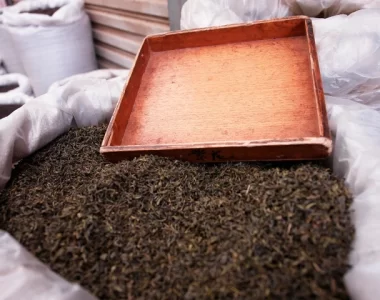People struggling with drug dependence sometimes ask if Kratom can help with their opioid addiction. While the FDA does not approve of Kratom as a drug, and while Kratom is not meant to treat or cure any affliction, scientific evidence is beginning to emerge that says Kratom may ease the symptoms of opioid withdrawal. Plus, anecdotal evidence and user experience also point to Kratom being effective during withdrawals.
The Opioid Epidemic has been wreaking havoc on individuals and communities across the globe. It’s a crisis that knows no boundaries, affecting people of all ages, backgrounds, and walks of life. With addiction rates soaring and devastating consequences piling up, it’s crucial to explore alternative solutions that can offer hope and relief.
Enter Kratom – an ancient herbal remedy that is gaining attention for its potential role in helping with opioid addiction. In this article, we’ll investigate how Kratom works in the body, examine its potential benefits for those struggling with opioid dependence, review the latest research and studies surrounding its effects on addiction treatment, and discuss considerations and precautions when using kratom as a possible solution.
The Opioid Epidemic and Its Impact
The Opioid Epidemic is a catastrophe that has left no corner of society untouched. From small towns to big cities, the impact of opioid addiction can be felt far and wide. Families are torn apart as loved ones fall victim to the clutches of opioids, struggling with physical dependency and psychological turmoil. The devastating consequences ripple through communities, straining healthcare systems, law enforcement agencies, and social services.
What makes this epidemic particularly alarming is its staggering death toll. Overdose deaths from opioids have skyrocketed in recent years, claiming countless lives and leaving behind shattered families grieving for their lost loved ones. It’s a crisis that knows no discrimination – affecting people from all walks of life irrespective of age, gender, or socioeconomic status.
Beyond the tragic loss of life lies a web of additional repercussions. The economic burden associated with addiction treatment and rehabilitation is immense – taking a toll on both individuals and society as a whole. Additionally, there are long-term health implications for those who manage to overcome addiction but are left grappling with chronic pain or other related health issues.
While addressing this epidemic requires multifaceted solutions involving prevention education, improved access to mental health resources, and stricter regulations surrounding prescription practices – it’s crucial to explore alternative options that could help alleviate some of the suffering experienced by individuals trapped in the cycle of addiction.
In light of these challenges posed by the Opioid Epidemic, many researchers have turned their attention toward Mitragyna speciosa as a potential aid in combating opioid dependence. This natural herbal remedy has been used for centuries in Southeast Asia for its medicinal properties – often praised for its ability to relieve pain while providing an energy boost without causing respiratory depression as traditional opioids do.
What is Kratom?
Kratom, scientifically known as Mitragyna speciosa, is a tropical evergreen tree native to Southeast Asia. It belongs to the same family as coffee and has been used for centuries in traditional medicine.
The leaves of the kratom tree contain alkaloids that interact with opioid receptors in the brain, producing pain-relieving and mood-enhancing effects. These alkaloids primarily include mitragynine and 7-hydroxymitragynine.
In its native regions, kratom leaves are often chewed or brewed into tea by people seeking relief from pain or fatigue. However, it has gained popularity worldwide due to its potential benefits beyond pain management.
Aside from its analgesic properties, Mitragyna speciosa is also reported to have stimulant-like effects at lower doses and sedative effects at higher doses. This versatile botanical has garnered attention for its potential to alleviate symptoms associated with opioid withdrawal.
Due to these unique properties, some individuals struggling with opioid obsession have turned to kratom as an alternative treatment option. While more research is needed on this topic, anecdotal evidence suggests that it may help reduce cravings and manage withdrawal symptoms during recovery.
It’s important to note that while kratom shows promise in aiding addiction treatment, it should never be considered a cure-all solution. Each person’s journey toward recovery is unique, and professional guidance should always be sought when considering any form of substance abuse treatment.
As with any herbal supplement or medication, there are risks involved when using Mitragyna speciosa. It can potentially lead to dependence or adverse side effects if misused or consumed in excessive amounts. Therefore, responsible usage and adherence to recommended dosages are crucial.
While the use of Mitragyna speciosa for opioid addiction appears promising based on personal accounts and preliminary scientific studies, further research must be conducted before drawing definitive conclusions about its effectiveness.
How Kratom Works in the Body
Kratom, a tropical evergreen tree native to Southeast Asia, contains alkaloids that interact with the body’s opioid receptors. These alkaloids, such as mitragynine and 7-hydroxymitragynine, have been found to have both stimulant and analgesic effects.
When consumed, kratom leaves are broken down in the stomach and intestines, releasing these alkaloids into the bloodstream. From there, they travel to various parts of the body, including the brain, where they bind to opioid receptors. This interaction can result in pain relief, mood enhancement, and increased energy levels.
One way kratom may help with opioid habits by acting on these same receptors but without causing respiratory depression or overdose risk. By occupying these receptors partially or fully without activating them completely as traditional opioids do, kratom may help reduce withdrawal symptoms and cravings associated with opioid dependence.
Furthermore, research suggests that Mitragyna speciosa has additional mechanisms of action beyond just interacting with opioid receptors. It also affects other neurotransmitter systems, such as serotonin and dopamine pathways, which could contribute to its potential benefits for addiction treatment.
It’s important to note that while kratom shows promise as a potential tool for managing addiction, more research is needed to understand its effectiveness and safety profile fully. Additionally, individual responses vary greatly when it comes to herbal remedies like kratom.
Suppose you’re considering using Mitragyna speciosa for addiction treatment purposes or any other reason for that matter. In that case, it’s crucial to consult with a healthcare professional who is knowledgeable about this botanical substance. They can provide guidance based on your specific circumstances and help you weigh the potential risks against possible benefits before making an informed decision about incorporating kratom into your wellness routine.
The Potential Benefits of Mitragyna speciosa for Opioid Addiction
Kratom, a tropical tree native to Southeast Asia, has been gaining attention in recent years as a potential alternative treatment for opioid addiction. While research is still ongoing, there are several potential benefits that Mitragyna speciosa may offer for those struggling with opioid dependence.
One of the main reasons why kratom is believed to be beneficial for opioid addiction is its ability to interact with the same receptors in the brain that opioids do. This interaction can help alleviate withdrawal symptoms and cravings without producing the same intense euphoria as opioids. Additionally, kratom has been reported to provide pain relief and mood enhancement, which can further support recovery from addiction.
Another potential benefit of kratom is its accessibility. Unlike prescription medications or other forms of treatment, Mitragyna speciosa can often be purchased legally and easily online or at certain stores. This makes it a more convenient option for individuals who may not have access to traditional treatment methods or who prefer a more natural approach.
However, it’s important to note that while there are anecdotal reports supporting the use of kratom for opioid obsession, scientific evidence is still limited. More research needs to be conducted in order to understand its effectiveness and safety profile fully.
As with any substance used for medicinal purposes, some precautions and considerations need to be taken into account when using kratom for opioid addiction. Dosage should always be carefully measured and monitored, as taking too much can lead to adverse side effects such as nausea or dizziness.
While preliminary findings suggest that Mitragyna speciosa may hold promise as an alternative treatment option for opioid habit, further research is needed before any definitive conclusions can be made. It’s crucial for individuals considering this approach to consult with healthcare professionals who specialize in addiction medicine and follow their guidance closely throughout their recovery journey.
Research and Studies on Kratom’s Effects on Opioid Addiction
Research and studies have been conducted to explore the potential effects of kratom on opioid addiction, shedding light on its therapeutic benefits. One study published in the Frontiers in Pharmacology found that individuals who used kratom reported reduced cravings for opioids and improved mood. Another study published in Drug and Alcohol Dependence showed that kratom use led to a significant decrease in self-reported pain and withdrawal symptoms among participants.
From The College of Pharmacy Website:
“There have been a lot of anecdotal reports suggesting kratom has some pain-relieving properties and has helped transition users from prescription opioids to this product,” said Chris McCurdy, Ph.D., a professor of medicinal chemistry in the UF College of Pharmacy. “Scientifically, this becomes one of the most important kratom studies released showing support as a potential treatment option for opioid withdrawal syndrome or opioid use disorder.”
Furthermore, research suggests that certain alkaloids present in kratom may act on the same receptors as opioids but without causing respiratory depression, which is a common side effect of traditional opioid medications. This indicates that kratom may provide relief from withdrawal symptoms while minimizing the risk of overdose.
While these initial findings are promising, it is essential to note that more research is needed to fully understand the long-term effects and safety profile of using kratom for opioid dependence treatment. Additionally, individual responses to kratom can vary, so healthcare professionals must monitor patients during their recovery journey closely.
Research indicates that kratom has potential benefits for individuals struggling with opioid addiction. However, further studies are necessary before definitive conclusions can be drawn about its effectiveness as a viable option for addiction treatment.
Considerations and Precautions When Using Kratom for Addiction Treatment
When considering kratom as a potential treatment option for opioid obsession, it is crucial to approach it with caution and take certain precautions. While many people have reported positive experiences using kratom to manage their addiction, there are still important factors to consider.
It’s essential to understand that the regulation of kratom varies from country to country and even within different states or regions. Therefore, it is crucial to research the legality of kratom in your area before purchasing or using it for addiction treatment.
Furthermore, dosage control is vital when using kratom. It is recommended to start with a low dose and gradually increase if necessary. This helps minimize the risk of adverse effects and allows you to find the optimal dosage that works best for you.
Additionally, remember that while kratom may help alleviate withdrawal symptoms and cravings associated with opioid habits, it is not a cure-all solution. It should be used as part of a comprehensive treatment plan that includes counseling, support groups, therapy, or other appropriate interventions.
Moreover, some individuals may experience side effects such as nausea, dizziness, constipation, and others when using high doses of kratom.
Furthermore, long-term use can potentially lead to dependence on this herb.
So, it’s always advisable not to exceed recommended dosages or longer duration usage without medical supervision.
Conclusion: Can Kratom Be a Viable Option for Opioid Addiction?
In light of the opioid epidemic that is plaguing our society, finding effective treatment options is crucial. While there are various approaches available, one potential alternative that has gained attention in recent years is kratom.
Kratom, derived from the leaves of the Mitragyna speciosa tree native to Southeast Asia, has been used traditionally for its stimulating and pain-relieving properties. However, its ability to potentially assist with opioid addiction recovery has piqued interest among researchers and individuals seeking alternative treatments.
Although more research is needed to fully understand kratom’s effects on opioid dependence and its safety profile, initial studies have shown promising results. Some evidence suggests that kratom may help alleviate withdrawal symptoms associated with opioids and reduce cravings by interacting with specific receptors in the brain.
However, it’s essential to exercise caution when considering kratom as an option for treating opioid obsession. The lack of regulation surrounding this natural substance means that quality control can be inconsistent. Additionally, there have been reports of adverse effects and potential risks associated with long-term use or misuse of kratom.
Before incorporating kratom into your treatment plan or recommending it to someone struggling with opioid addiction, it’s essential to consult with a healthcare professional experienced in addiction medicine. They can provide guidance tailored to individual needs and ensure safe usage.
While preliminary research suggests the potential benefits of using kratom for addiction treatment, further investigation is necessary before making any definitive conclusions about its efficacy and safety. It remains imperative to explore a comprehensive approach that includes counseling, support groups, therapy modalities like medication-assisted treatment (MAT), and medical supervision.
The journey towards overcoming addiction is complex and multifaceted; therefore, exploring multiple avenues under professional guidance provides the best chances of success.
Further reading Kratom For Opioid Withdrawal – Natural Products Can Help.
———–
Warning: This product has not been approved by the FDA. It is not intended to diagnose, treat, prevent, or cure any condition or disease. Mitragyna Speciosa products should not be used by pregnant or breastfeeding women. Not to be used while operating a motor vehicle or machinery. Always consult a doctor before using any new botanical product. By using this website, you agree with our Terms of Service page stating that you are over 18 years old and of legal age to buy Kratom at your location.
NOTE: We do not ship Kratom to states that are not permitted.







